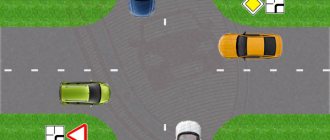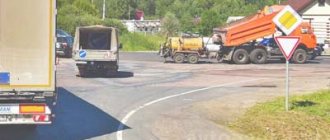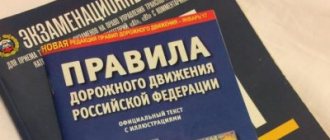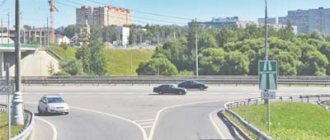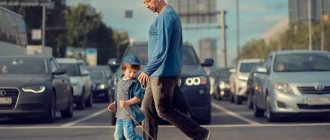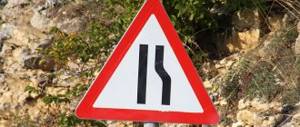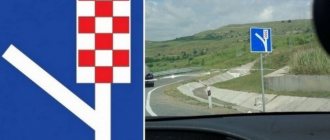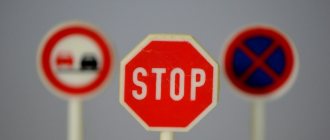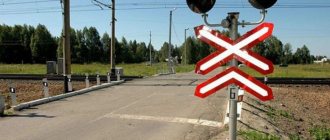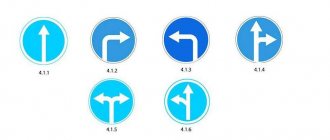In today’s article we will discuss the “Main Road” sign (2.1), which raises many questions among both beginners and motorists with decent driving experience. As a rule, the most difficult thing for them is to figure out exactly how a given sign works in places where the road changes its direction, and also to determine where its coverage area ends. We will consider these and some other topics related to the mentioned sign in more detail.
Which section of the road is indicated by sign 2.1
The "Main Road" sign is one of those that indicate priority. It is installed on a road that has an advantage over the roadway crossing it. And they do this, as a rule, in places where the intersection is not regulated, or there is an entrance from such a section of the road to the intersection.
In other words, the sign described determines the order of crossing through an uncontrolled intersection (by the way, the traffic light and the traffic controller cancel the effect of this sign). An additional sign (8.13) can be installed underneath it, indicating in which direction the main road goes, and the driver must take this into account to set the order of crossing the intersection.
Opposite signs
Give Way
There is one pointer that can be contrasted with the 2.1 label. This is a "Give Way" sign. It means that the driver is moving on a roadway that is not endowed with any right of way, and he should let other road users pass before passing the intersection.
It looks like an inverted white triangle with a red frame.
Sometimes a red octagon is installed along with it, on which STOP is written in white letters. This is a sign called “No driving without stopping.” This means that a driver approaching an intersection must stop before continuing. Stopping is necessary even if it seems to you that there are no cars around. There is a fine for violating this requirement.
Additionally
Primary and secondary traffic direction indicators can also be installed with such a mark so that drivers can better understand which direction the traffic has priority.
What does a sign indicating a main road look like?
The road on which you must yield to traffic is indicated by a sign in the form of a yellow diamond in a white frame. The “Main Road” sign has this shape for a reason; it has no analogue, so the sign is easy to spot at any section of the intersection, even from the rear side. And this will help the driver correctly determine the order of passage through a difficult section of the road.
For greater safety, experienced drivers are advised to slow down when approaching an intersection and carefully examine its right corner. If there is no sign, look at the left corner, which is located closer to the person driving, and then at the one further away. This will help you accurately navigate and understand whether you should give way.
How can you determine which road is the main one if the sign is not installed?
In every locality, the “Main Road” sign, a photo of which you can see in this article, is installed in front of intersections. But let's also clarify how you can determine the main road if this sign is not there?
In such cases, both the road surface and the location of adjacent roads will help you out. Only the one with a hard surface in relation to the unpaved ones, or the one that is adjacent to exits from nearby territories, will receive the main status.
By the way, keep in mind that even if there is a pavement on the secondary road in the area adjacent to the intersection, it still does not become equal in importance to the one that crosses it.
the main road
| 1. | For everyone. |
| 2. | On the upper and lower left. |
| 3. | Only on the top left. |
The main road is shown in the upper and lower left pictures, as evidenced by the "Main Road" and "Intersection with Minor Road" signs installed on these roads. The dead end sign shown in the top right picture informs drivers that there is a road on the right that does not have a through route.
| 1. | For everyone. |
| 2. | On the bottom and top right. |
| 3. | Only on the top right. |
The main road is shown in the lower and upper right pictures, as evidenced by the “Main Road” and “Minor Road Junction” signs installed on these roads. The sign “Take advantage of oncoming traffic”, shown in the upper left figure, informs drivers only about the order of passage of this section of the road.
Now let's talk about what this sign means and what advantages it provides to the motorist.
We can consider the main road to be that section of the road that is located behind mark 2.1 to the first intersection along the way.
However, the rules also state that the main road is any paved roadway in relation to the adjacent dirt road. In this case, placing a sign defining priority is not necessary.
You need to remember that on this section of the road you have an advantage over those moving on secondary roadways. However, this does not mean that you need to rush headlong, knowing about your advantage, ramming everyone and everything.
You need to remember that road situations vary. Sometimes you need to let the other car complete the maneuver. In the end, do not forget that not all car enthusiasts can boast a level of attention comparable to yours. And some driver’s license holders are completely unfamiliar with the types of road signs.
Sign installation location
The “Main Road” road sign is placed taking into account the distance to the place where it begins to operate. That is, this sign can be installed immediately before the intersection, which will be subject to this restriction.
Before all intersections, the described priority sign is repeated. This precaution is necessary due to the peculiarities of the operation of the signs “Give way” (2.4), “Intersection ...” (2.3.1) or “Adjacent to a secondary road” (2.3.2 - 2.3.7), installed before leaving adjacent side streets. All of the listed signs do not inform that the road being crossed is the main one, but only require you to give way with or without a mandatory stop. In order to supplement the information, sign 2.1 is duplicated.
By the way, instead of the once again repeated “Main Road” sign, one of the varieties of the “Adjacent to the Main Road” sign is sometimes used. But taking into account the fact that it is installed not directly in front of the intersection, but at a distance from it, this is quite difficult to do in urban conditions. Therefore, this combination is used more often not in populated areas, but behind them.
Advantage of movement
In rules 2.1 there is a sign indicating movement on the main road. This sign is quite rare; it can be recognized from any angle, even if it:
- covered with snow;
- covered in mud;
- burned out in the sun.
The sign has the shape of a diamond, is painted light yellow and has a white border around the edges. Such coloring helps to recognize it in any weather, as well as in various situations occurring on the road. In accordance with the terms of the current standards, it is necessary to install this kind of sign on a ready-made support, which should be located at the edge of the road on the right side.
However, on some secondary roads you can see warning signs, which in the traffic rules belong to the designation 2.4. These symbols are very similar to the main road signs, both have the same shape of an equilateral triangle and are mounted with the apex down. This feature, in turn, also allows one to recognize a sign under different circumstances. The sign has a triangular shape, is painted white and has a wide border of bright red around the edges.
In many cases the sign 2.5 is still used. It has the shape of an octagon with the inscription STOP in white. This sign, compared to the one mentioned above, not only determines priority, but also does not allow you to cross the intersection without reducing speed until you stop.
1. Yard roads.
2. Access roads.
3. Technological paths of enterprises.
4. Driveways.
5. Lanes.
In addition to all this, a road that has a hard surface of any type has an advantage over dirt roads, and does not depend on their directions or sizes. The only exception can be an installed sign indicating the advantage of a dirt road as the main one.
Sometimes on country roads the “Main Road” sign is not placed at all intersections. And therefore, the road will be of paramount importance until you come across the required sign, described in the rules under numbers 2.2. The reason for the end of the influence of the sign may be the passage of populated areas, as well as changes in the road surface. If the road surface is the same, you should adhere to the rule - obstacles on the right.
| 1. | Yes, but without interfering with the truck. |
| 2. | Yes. |
| 3. | No. |
At the intersection of unequal roads, the Rules do not prohibit you from turning left at the same time as a truck, since when passing on the right sides, the trajectories of the vehicles do not intersect. However, while on a secondary road (signs and ), you must make sure, firstly, that the truck has actually begun to turn left and, secondly, that, taking into account the dimensions of the vehicles and the width of the roadway, you will not interfere with it during the turn.
In the set of traffic rules this sign is listed as number 2.1.
Appearance
The road sign “Main Road” is easy to recognize among others. It is made in the shape of a rhombus. The inside of this sign is yellow and has a white frame.
Coverage area
The “Main Road” sign applies to the section of the route up to the first intersection along the route.
However, sometimes, to make drivers more confident, a sign is also installed on the roads, indicating the end of the coverage area of the advantage. It looks like pointer 2.1, but has the number 2.2 and the diamond in this case will be crossed out.
Traffic light
It must be remembered that if the “Main Road” sign is installed next to a traffic light, then the relevant settings will be those provided by the light controller. In this case, road markers begin to operate only if this intersection becomes uncontrolled (when the traffic light is turned off or its blinking yellow light).
If a yellow diamond is installed near the road in splendid isolation, it means that the main road goes straight. However, there are markers that indicate where the priority lane turns.
Such signs are made in the form of white squares. They show a drawing of an intersection, and the main road is highlighted with a “thick” black line.
If you are going to drive through an uncontrolled intersection with a “Main Road” sign and an indication of its turn, but cannot miss a car that is also moving on the priority roadway, remember the right-hand obstruction rule. The driver whose car is such a hindrance for the other will have an advantage.
The sign marking the main road does not always look like the familiar yellow diamond. Every driver needs to know and remember about these marks. Since they are installed infrequently and mostly outside the city.
Therefore, the unexpected appearance of such a sign sometimes confuses motorists. These are pointers numbered 2.3.1 onwards. They are called "Minor Road Intersection Signs" or "Minor Road Junction Signs".
Appearance
These marks appear as white triangles with a red frame. A road branch is depicted inside the triangle. The main road on it is highlighted with a “thick” line. The secondary roadway looks noticeably thinner.
We suggest you read: Is a work-related injury caused by an accident on the way home?
Give Way
There is one pointer that can be contrasted with the 2.1 label. This is a "Give Way" sign. It means that the driver is moving on a roadway that is not endowed with any right of way, and he should let other road users pass before passing the intersection.
It looks like an inverted white triangle with a red frame.
Sometimes a red octagon is installed along with it, on which STOP is written in white letters. This is a sign called “No driving without stopping.” This means that a driver approaching an intersection must stop before continuing. Stopping is necessary even if it seems to you that there are no cars around. There is a fine for violating this requirement.
Additionally
Primary and secondary traffic direction indicators can also be installed with such a mark so that drivers can better understand which direction the traffic has priority.
Sometimes the driver has priority not only at an intersection, but also on a straight road that does not intersect with any roadway. Priority signs are also installed there. But others.
These signs are called "Give Way to Oncoming Traffic" and "Give Way to Oncoming Traffic." They mean that a motorist moving in the main direction has the right to pass a certain section of the road first.
Most often, such signs are installed on very narrow sections of the road where only one car can fit.
We know that in the absence of signs, an uncontrolled intersection is crossed according to the principle of “interference on the right.” However, what to do if a car is moving from each of, for example, four directions? After all, for each of the machines there is an obstacle on the right in this case.
This is one of the nonsenses of traffic rules. The fact is that this situation is not regulated in any way by road rules. You can drive through such areas as you wish. However, it is better to do this carefully.
| 1. | Must give way only to buses. |
| 2. | Must give way to cars and buses. |
| 3. | You have an advantage. |
You and the bus driver are on the main road (Main Road sign) and therefore when turning left you must give way to the bus. You have an advantage over a passenger car because it is on a secondary road.
| 1. | Yes. |
| 2. | No. |
Area of operation of the "Main Road" sign
In populated areas, by the way, duplication of this sign is required before each intersection also because in fact it does not have any coverage area other than the installation location, because it suggests priorities only at the intersection where it is located.
If the sign is installed at the beginning of the road (namely behind the intersection), then its effect is extended to the entire section of the road. And where the road ceases to be the main one, sign 2.2 is installed indicating this. By the way, remember that this sign does not immediately turn the road into a secondary one, it makes it clear that in front of you there is an intersection of equivalent roads.
How does the “Main Road Changes Direction” sign work?
If there is no sign under the sign, it means the priority road is going straight ahead. In cases where its direction changes, an additional sign is installed.
As experienced drivers confirm, it is most difficult to plan your actions at those intersections where the direction of the main road changes. This section of roads combines problems of two types: the intersection of equivalent and unequal intersections. And the main mistake of motorists in such cases is that they take into account only those signs that they see, without thinking about other corners of a given intersection (we have already discussed this above).
Imagine the situation when you are at an intersection with a changing direction of the priority road. Both you and the driver standing, for example, on the right before the intersection, see the same “Main Road” sign, which gives you priority in traffic! And this is usually discovered only later, after the accident! So what is the right way to act in such conditions?
Signs with similar meanings
Sometimes the driver has priority not only at an intersection, but also on a straight road that does not intersect with any roadway. Priority signs are also installed there. But others.
These signs are called "Give Way to Oncoming Traffic" and "Give Way to Oncoming Traffic." They mean that a motorist moving in the main direction has the right to pass a certain section of the road first.
Most often, such signs are installed on very narrow sections of the road where only one car can fit.
Algorithm for driver action in case of changes in the direction of the priority road at an intersection
- When at such an intersection, do not forget to think about all its sides and be sure to take into account sign 8.13, which will show the direction of the main road.
- You can mentally place this sign in the center of the intersection, and then a wide line will show the main road, and two narrow lines will show the secondary ones.
- Having temporarily erased the secondary ones from your consciousness, you must remember the main area. Then both you and the driver on the other half of the main road must act according to the “Interference on the right” rule.
- Naturally, the one who does not have such an obstacle will move first.
- And only after the cars leave the main area, the vehicles on the secondary roads begin to move according to the same pattern.
Please note that in this way a difficult intersection can be divided into two symmetrical and easy-to-traverse halves.
You intend to continue straight ahead. Who should give way to?
| 1. | Only for a motorcycle. |
| 2. | Motorcycle and car. |
| 3. | No one. |
When entering an intersection of unequal roads on the main road (signs “Main Road” and “Main Road Direction”), you take advantage of trucks and cars on secondary roads. With a motorcycle that also enters an intersection on the main road, you pass according to the rules for passing intersections of equivalent roads, having in this case an advantage. This means that you should not give way to anyone.
| 1. | Both vehicles. |
| 2. | Passenger car only. |
| 3. | Only by bus. |
This is an intersection of unequal roads (Give way sign and “Main road direction”). The main road at the intersection changes direction. You are approaching the intersection on a secondary road and, therefore, are required to give way to both vehicles moving on the main road, regardless of the direction of their movement.
| 1. | Only to the left. |
| 2. | To the left and in the opposite direction. |
| 3. | In any direction. |
- U-turns at intersections are not prohibited.
- Signs “Main Road” and “Main Road Direction” also do not limit the direction of movement.
| 1. | Only A. |
| 2. | Only B. |
| 3. | Only A and B. |
| 4. | All. |
| Sign A “Adjacent to a secondary road” refers to priority signs and informs you that you are on the main road and at the intersection have priority over vehicles approaching from the left. |
| Signs B “Give way” and “Direction of the main road” inform about the need at the intersection to give way to vehicles approaching on the main road (the direction of the main road is shown on the sign) both from the left and from the opposite direction. |
| Sign B “Exiting onto a road with a lane for route vehicles” does not establish the order of passage through the intersection and only informs about entering a road where the oncoming lane is allocated for route vehicles. |
The correct answer is Only B.
| 1. | Passenger car only. |
| 2. | Only for a truck. |
| 3. | Both vehicles. |
Since you are on a secondary road (signs “Give way” and “Direction of the main road”), you can drive through an intersection of unequal roads, giving way to both vehicles that are moving on the main road.
| 1. | Passenger car only. |
| 2. | Passenger car and motorcycle. |
| 3. | No one. |
At this intersection of unequal roads (signs “Main Road” and “Direction of the Main Road”), you must give way only to a passenger car approaching from the right, which, like you (traffic rules 13.10), is on the main road, and therefore pass with They follow the rules for driving through intersections of equivalent roads. The motorcycle and truck give way to you as they are on secondary roads.
We suggest you read: What is more important: Pvtr or employment contract
| 1. | Passenger car only. |
| 2. | Only for buses and cars. |
| 3. | All vehicles. |
Since you are approaching the intersection on a secondary road (signs “Give way” and “Direction of the main road”), you must give way to buses and cars. In relation to the motorcycle, you have priority (traffic regulations 13.11), since both are on secondary roads (traffic regulations 13.10).
| 1. | Only for a motorcycle. |
| 2. | Only for motorcycles and cars. |
| 3. | Only bus and motorcycle. |
| 4. | All vehicles. |
At this intersection of unequal roads (signs "Give Way" and "Main Road Direction") you must give way to a motorcycle and a bus as they move along the main road. You should also give way to a passenger car approaching from the right, when passing which you must follow the rules for driving through intersections of equivalent roads.
| 1. | Only by tram. |
| 2. | Passenger car only. |
| 3. | Tram and car. |
| 4. | All vehicles. |
At this intersection of unequal roads, where the main road changes direction (signs “Main Road” and “Main Road Direction”), the order of passing with a tram and a car is determined by the rules for passing intersections of equivalent roads, since both you and they are on the main road.
| 1. | Go through the intersection first. |
| 2. | Give way only to the tram. |
| 3. | Give way only to trucks. |
| 4. | Give way to both vehicles. |
When the traffic light is flashing yellow, the intersection is considered unregulated. Using the "Main Road" priority sign, you can pass through this intersection first, taking advantage of both the truck and the tram located on the secondary road.
| 1. | Only A. |
| 2. | A and B. |
| 3. | All. |
Advantage when driving through unregulated intersections is provided by signs indicating the main road: signs “Main Road” (A) and “Adjacent to a Secondary Road” (B). The sign “Take advantage of oncoming traffic” (B) is used on narrow sections of roads where oncoming traffic is difficult to pass. The correct answer is A and B.
| 1. | Go through the intersection first. |
| 2. | Give way to the tram. |
You and the tram are on the main road, and therefore, when determining the order of passage of this intersection, you should be guided by the fact that the tram has an advantage over trackless vehicles moving in the same or oncoming direction along an equivalent road, regardless of the direction of movement.
| 1. | Yes. |
| 2. | No. |
When driving through an intersection of unequal roads in the direction of the main road in the forward direction, you take advantage of an oncoming car turning left, since an orange or yellow flashing light does not give you an advantage in traffic.
| 1. | Give way to a truck. |
| 2. | Give way to both vehicles. |
| 3. | Go through the intersection first. |
When the traffic lights are off, the intersection is considered uncontrolled, and drivers must follow the priority signs. The truck, like you, is on the main road, and therefore, when turning left, you must give way to it. You have an advantage over a passenger car, since it approaches the intersection along a secondary road.
At this intersection of unequal roads (signs “Main Road” and “Main Road Direction”) you must give way only to a passenger car approaching from the right, which, like you, is on the main road, and therefore you should pass it along rules for driving through intersections of equivalent roads. The motorcycle and truck give way to you as they are on secondary roads.
If there is such a sign in front of you, you must know that you have priority over vehicles traveling in the other direction. When there is such a sign at an intersection and there is no explanatory sign, you need to clearly understand that the road that leads exclusively straight is the main one. Having noticed the presence of sign 8.13, imagine it in the center of the intersection and evaluate your path, and think about whether you have priority over other vehicles.
It is also necessary to know that the influence of the “Main Road” sign concerns every motorist present on it. Very rarely, but unpleasant situations do occur due to misunderstandings. The reason for all this is the lack of desire on the part of a driver driving on the main road to give way to a person leaving it.
In this regard, in such situations, you should use other rules, and do not forget about the interference on the right. Priority is given to those who fall under this definition. This in no way applies to those drivers who enter the main road from a secondary one. Since they must let through all vehicles with priority, and only then continue their movement.
However, there are also situations when the sign loses its influence. For example, if there is a traffic light at the intersection or there is a traffic controller at it with all the appropriate insignia and in the required uniform. Then you should use only their signals to determine the degree of advantage of any transport. If the traffic light is not working, is turned off or the yellow lights are flashing, then adhere to the sign.
Don't think that a "Main Road" sign gives cars priority over pedestrians. Provided that the infrastructure has all the proper markings and, of course, designations, it is necessary to act in accordance with the rules. Often, at a controlled intersection, you should follow the traffic lights or the traffic controller, and all other signs oblige you to give way to the same motorists.
When a sign is located outside of town and designates a main road, it can determine both priority and restriction. In such areas, stopping is prohibited. First you need to wait for a road pocket or the first exit, which in any case is on the highways. However, there may be an exception, this is a stop due to an accident that occurred on the main road or another emergency. For such a violation, the traffic police inspector may issue you a fine, and to prevent this from happening, you will need to present him with strong evidence.
We suggest you read: The employer does not want to allow you to go on vacation
As for the main road, the main rule is that motorists who drive in the correct direction have priority. But it is worth remembering that you must adhere to other rules, including the advantages of vehicles located on the right, as well as requirements regarding maneuvering.
On roads that are not marked, it is very difficult to find the main road, but you can do it if you look at the surface or the purpose of the path. In addition, when driving along the main road, be careful and careful, because car owners do not always follow the rules.
Sign violation
Remember also that if the driver violates the requirements of a road sign, namely, by failing to give priority to a car at an intersection, such actions are qualified in accordance with Article 12.13 of the Code of Administrative Offenses of the Russian Federation and are punishable by a fine of 1,000 rubles. And in case of driving where it was prohibited without stopping, the driver is punished under Art. 12.16 Code of Administrative Offenses of the Russian Federation with a warning, or he will be fined in the amount of 500 rubles.
Get yourself a table of traffic police fines, which will give you the opportunity to navigate the degree of punishment for any violations of the rules.
Advice for those who enter an intersection on what is considered the main road
And finally, I would like to convey to those who approached the intersection, having passed the “Main Road” sign: please note that drivers who are at that moment on a secondary road do not remember the rules of the road!
Don't forget this for a minute and don't try to cross the intersection right away. First, stop and make sure that they are giving way to you, and only after understanding this, continue moving. Only this attitude towards the road will make your journey safe, and you will successfully and without incident get to where you were in a hurry.
